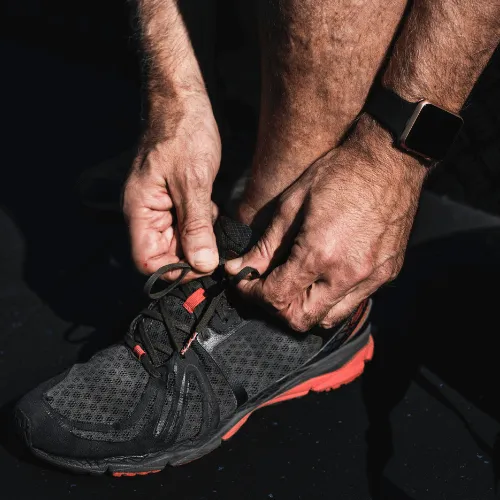Written by Scott Kaylor
I am a runner, certainly not an elite runner, but nonetheless a runner. I have written before that I am wired to enjoy running and other endurance adventures. One of the mantras I tell myself when the running gets tough is, “Scott, you do hard things.” So, when I read about others’ experiences doing consecutive day running streaks I was intrigued.
In 2020 my race events were canceled due to the pandemic, so I needed some sort of goal to stay motivated to exercise. I set a goal to run for 50 consecutive days with a friend. I made it 64 days (he ran 100 days). When 2021 rolled around, I needed some motivation to get on track for an IM 70.3 event that had been rescheduled from 2020. Setting a consecutive running day streak goal to gain consistency made sense to me; 100 days.
During the 100 days I learned and confirmed a few things:
1. My legs craved my daily runs
This was the most exciting and surprising benefits of streaking. The thing that stood out the most during that first streak was how much my legs craved my run for the day. After the first 10-days or so of my 100-day journey my legs had that feeling again. Regardless of the distance or intensity of the run the previous day I always felt good running (at least physically, keep reading to hear about the mental and schedule hurdles).
- Side note from your PT: if you are new to running I would recommend a non-running cross training day in between your runs to allow your muscles and tendons time to recover. You may also benefit from starting with a walk:run program where you alternate walking and running for a number of cycles and gradually increase the amount of running time as your body adapts to running. We have one of these free running program reports available on our website.
2. Easy runs facilitate faster and longer runs
I typically tried to include a speed day, a tempo day, and a longer run day each week with shorter runs in between those key workouts. That didn’t always happen since I am a husband, father of four, and a small business owner. I had some weeks that consisted of mostly my 10-minute runs. I joked that I may have run the fewest miles of anyone who ran for 100 consecutive days. Regardless of those weeks where it was bare minimum just to keep streaking I was able to jump back into my other workouts without missing a beat. This may not work as well for more elite runners but was certainly the case for me. I would say I’m an above average age-group level runner. Most of the runners that I work with in my clinic need to get better at running easy. The irony of this is as we get better at mastering this our easy runs start to be at faster paces with lower heart rates. If you can make easy runs easy and hard runs hard, you’ll see some great improvements in your running ability. I believe running is a skill that needs to be nurtured just like any other sport. The more we run, the better we get at it.
3. Strength and targeted mobility training is key
I had to discontinue to my previous 64-day streak because of some quadriceps pain I began having a few days prior to day 64. When I reflected on why I started having pain; I could see it was partly due to that I had neglected my strength training. For this streak I wanted to make sure I practiced what I preach as a physical therapist and incorporate strength training consistently. It paid off big time! I achieved my goal in my IM 70.3 event and was even able to run the next day without any issues to keep the streak alive.
4. Listen to my body
Running daily allowed me to get in tune with my body. Some days I felt like running further than the plan, so I did. Some days I didn’t feel like running as far as planned, so I didn’t. This allowed me to be consistent and enjoy the process. I wasn’t beholden to paces, but one metric I did focus on was cadence. I spent the streak trying to hone form and comfort running to try to maximize efficiency.
5. Helps overcome excuses (i.e., time, weather, etc.)
Most of my workouts must happen before my kids wake up or after they go to bed. There were definitely some days that I didn’t want to run, even though I physically felt like running, due to feeling too busy with family or work responsibilities, due to bad weather, and sometimes due to a desire to sleep in later or go to bed earlier. That is why setting a minimum goal was important. Mine was 10-minutes. It’s hard to make an excuse to not at least run 10-minutes! Once I started my run, I never regretted it and I was always glad I did it when I finished.
6. Accountability is helpful
I have a core group of guys, and one friend in particular, who I check in with routinely to stay on track. It was fun to be able to celebrate milestones with other people. It was also helpful to check in when motivation was waning to stick with the program to achieve the goal.
My running streak was a great experience. It was fun, there was a great sense of accomplishment throughout, it was a great way to build an endurance base, it created consistency, it helped hone my running form, and fostered relationships with my running buddies. If you are currently in a training cycle, particularly an intense training cycle, you may want to stick with it and postpone streaking. But for everyone else, give it a go. Set a goal, lace up your running shoes, and enjoy!
Want running tips and resources sent straight to your inbox?
Sign up for our Soggy Sock Newsletter to get running-related emails sent to you every other week. Also, visit our website for our tip sheets on our runner’s checklist, favorite exercises for runners, and other free running resources!
Have you heard about our Coaching Package Promotion?
With your 3-month coaching package, we’ll include a FREE CUSTOM INSOLE (normally $249)!
A 3-month coaching package includes a start-up assessment ($100) and monthly recovery and strength sessions ($500). Call us to learn more!
About the Author: Scott Kaylor
Scott graduated from the University of Tennessee in 2005 with a degree in Exercise Science. He earned his doctor of physical therapy degree from Duke University in 2009. He then fine-tuned his sports medicine skills through APTA-credentialed sports residency and upper extremity fellowship programs. These provided the opportunity to serve professional, division I and II collegiate athletes, youth and high school athletes, and endurance athletes of various ability levels. Scott has served as the team physical therapist for the University of West Georgia and Central High School. Scott’s fellowship provided the opportunity to serve on the Kansas City Royals sports medicine staff in Surprise, AZ in 2012.
Since 2012, Scott has been working in the Greer area, serving athletes and exercisers of all ability levels, people frustrated with persistent pain, and patients who have undergone orthopedic surgery. He is passionate about providing people with the individualized care they need to reach their goals.



